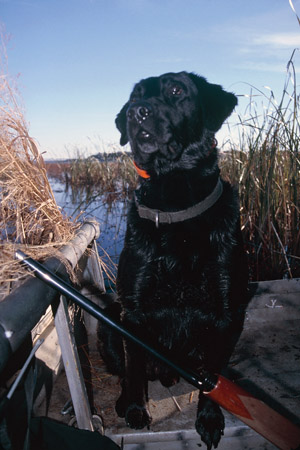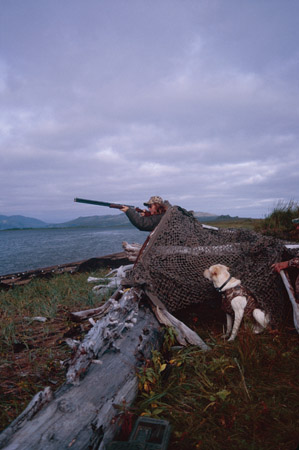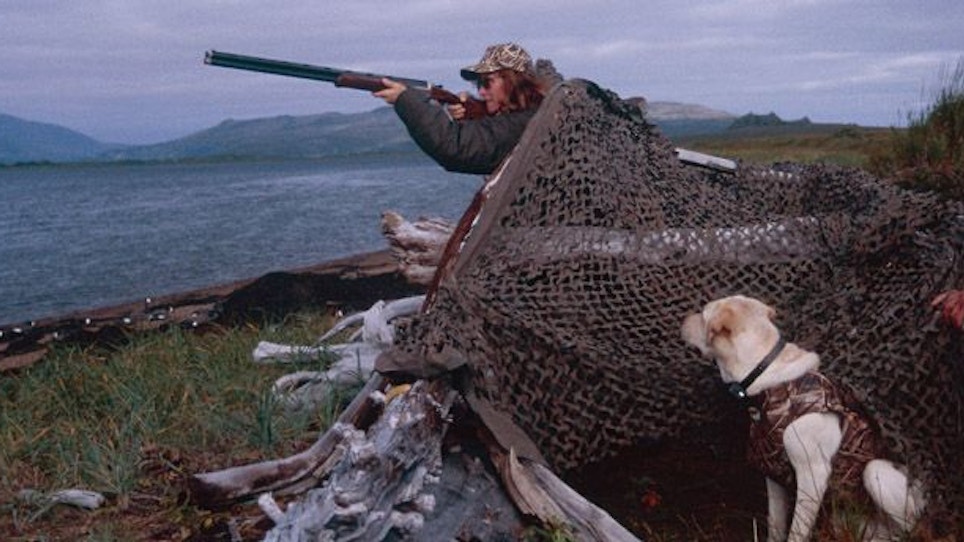 Jennifer L.S. Pearsall (JP): George, just what is gun-shyness in a dog? Is it loud noises in general or is it the particular loudness or decibel range of shotgun fire?
Jennifer L.S. Pearsall (JP): George, just what is gun-shyness in a dog? Is it loud noises in general or is it the particular loudness or decibel range of shotgun fire?
George Hickox (GH): Neither. Gun-shyness in a dog is completely attributable to environmental circumstances. It is most likely to happen during the imprinting stage of a pup’s growth, or it can be encouraged by a bad event later in life. Regardless, simply put, gun-shyness is a negative association with the gun.
JP: Okay, let's start with the first. What's the imprinting stage, and what does it have to do with gun-shyness?
GH: The imprinting stage of a dog's life is during the age span of six weeks to 20 weeks. It is during these weeks that it takes fewer repetitions for something to become a learned behavior. Thus it's easier, when the training method is correct, to teach "sit" to a dog during this time, than it is, say, to a three-year-old. Within that six- to 20-week period, though, is an additionally crucial period of time. It’s one I call the "fear factor" stage, and it's the weeks that range from eight to 10. It's a terrible time to have something happen to your pup that he’s going to associate as being unpleasant, because the association happens fast and sticks — it's going to be very difficult to undo that association later. That's why a gun introduction during this stage of a pup's development is usually a poor idea.
JP: Are you saying you'd never introduce the gun to an eight- to 10-week-old pup? That seems young to me anyway, but is this a totally hands-off period?
GH: No, but you do have to have a lot of other factors in place to introduce the gun successfully, and I don't think most amateur trainers have the time or resources to make sure all those things are there before they do start with the gun.
JP: What factors are you talking about?
GH: First and foremost the dog must be aggressively, and I mean aggressively, chasing birds. If your pup is consistently, reliably, chasing hard after clipped-wing birds in the field, then he's ready for introduction for the gun. If there's any apprehension with the bird, no gun. That's my benchmark for feeling out this stage. Obviously, some are going to take longer than others to get to this stage, but it's probably the single best indicator I'm going to have.
As I said earlier, gun-shyness occurs when a dog has a negative association with gunfire. So if your pup hesitates at a bird flushing and flapping in his face and you choose that moment to introduce the harsh noise of gunfire, he's very quickly going to make the association that gunfire means he's about to have an unpleasant experience with the bird. The gunfire becomes the cue that bad things are going to happen, and that's why it's so important that your dog wants the bird more than anything before you start discharging shotshells.
I'll make one other note here. We do not go to the skeet range, fire a gun during the dog's dinner, or any of the other things you've heard work to gun-proof your dog, because we want his focus to be on the bird. Birds and only birds go hand-in-hand with the gun.
JP: So let's say my pup's at that stage, I turn him loose in the field and he's snapping and leaping at the clipped-wing pigeons I've planted as he roots them up and he's running after them like his life depends on it when I throw them. Now what? How do I make sure the gun introduction is a pleasant thing?
GH: To be perfectly clear, the gun introduction should come before any other real training occurs. The dog shouldn't be on line drills — there's no check cord, no bird manners, nothing. He just needs to be undeniably enthusiastic about getting the bird.
For gun introduction you'll need two things — an assistant and a supply of clipped-wing pigeons. First time out, the assistant also needs to have a gun that fires a .22 crimp round, usually a starter pistol, but the type of round used is important. The .22 crimp has a fairly flat sound, unlike the sharp report of a standard starter pistol round.
With the assistant standing 50 yards away from you and the dog, throw out a clipped-wing pigeon in an area of mowed grass where the dog can easily see the bird. The minute the bird hits the ground, the assistant should fire the gun, one shot only. If the pup shows any indication that he's heard the gun — he stops and looks for the sound, he runs back to you, picks up the bird and drops it, or even just hesitates in his stride to peer around a bit before picking up the bird — go back to just birds with the dog. Birds have to overpower the sound of the gun, otherwise you open up the door to create a negative association with the gun. Even if that negative association never becomes severe, you'll never have the hunting partner you should. For example, say your Lab merely ducks his head when you start swinging on mallards. Doesn't seem like a big deal, but if he's ducking his head, he's not marking the bird, and now you have a very real problem in bird recovery.
Now if the pup did ignore the gun and continued on for the bird, you're on the right path. Do the exercise again, and it's your choice how many pigeons you want to run through and how many days you want to continue with the starter pistol, but when you're not noticing any apprehension at all on the dog's part as he goes for the bird, move your assistant in closer. Try just 10 yards at first, repeating the drill as before. If the dog hesitates, move the assistant back out.
If you and the assistant are virtually next to each other when the dog runs for the bird, now it's time for the next level. Move your assistant back out to 50 yards and equip them with a .410 shotgun. You'll mirror the steps of the training with the starter pistol, and when that's completed, you'll repeat again with a 20-gauge.
Once I have the 20-gauge firing closely to where I'm working with the dog and the pigeon, I'll transition to actually shooting the bird. Now, I won't do this all the time. Sometimes I'll hit the bird, sometimes not, and sometimes I won't shoot at all, because I don't want the dog to anticipate the gun — simply seeing a bird shouldn't equal gunfire in the dog's mind. His mind should be "Birds, birds, birds, I gotcha, I gotcha!"
 JP: Is that the end of the gun training? Do I never have to worry about creating a gun-shy dog after this?
JP: Is that the end of the gun training? Do I never have to worry about creating a gun-shy dog after this?
GH: What you have at this point is a dog that associates gunfire with good things happening. He's gun-broke, but he's not a gundog yet. Right now his experiences outside these basic bird and gun exercises are pretty limited. In fact, I like to get my birds and guns behind me before moving to even basic obedience, because this is the time in the dog's life when he hasn't had any correction. He thinks he owns the world. And you don't want to have introduced correction before you introduce gunfire, because your dog won't be in his boldest frame of mind. Even in basic obedience, you have pressure and correction, and that opens the door for the dog to wonder if something's wrong or if he's done something wrong. Either will make him a bit apprehensive, behavior you'll see exhibited later as he learns about force-fetching, line drills, blind retrieves, whistle and hand cues, and all the other things that will make him a finished dog. That's fine then, as he figures out the rules, but it's not fine during gun introduction.
On the same note, just because you've gotten your pup gun-broke doesn't mean you should take him to South Dakota for the pheasant opener or to Stuttgart for the first weekend in duck season. Though your dog now has an association between gunfire and birds, it's certainly a limited one. You and your assistant shooting one or two birds at a time is about as different in your dog's mind from 20 gunners blocking and shooting long-tailed roosters in the corn belt as Earth is from Mars. And taking him from the one situation to the other would do to his little dog mind what the two planets would do if they collided.
JP: Now let's go back and address the second question I had. Is it possible for a gun-shy dog to be created later in life?
GH: Sure. Anytime you've got enough bad experiences the dog can associate with the gun, bad experiences that override the good experience of the bird, you can create a gun-shy dog.
JP: Can you give me an example?
GH: Absolutely. Say your regular hunting buddy is a terrible shot and screams and curses and throws his shotshells all over the blind every time he gets up to shoot. Now, do you think it’s possible your dog might begin to associate gunfire with a fairly unpleasant set of circumstances? Sure he might. And, yes, he might only associate it with that particular human being present, but then again he might not. If he doesn't associate a bad day in the field only with four-letter-word Frank and is instead acting like he wants to stay in the kennel whenever the decoys come out, then you've got a retraining issue on your hands.
JP: You just mentioned retraining. It's possible to correct a gun-shy dog?
GH: Depends. Quite honestly, a dog that’s been made gun-shy during the imprinting stage will be very difficult if not impossible to retrain. But if you have a dog that became gun-shy later in life after too many repeat negative associations in the field, then yes, it's possible, though the length of time to correct will depend on several factors, such as the extent of the trauma, the type of trauma, and possibly the age of the dog.
While it's important to get the dog gun-broke before you introduce the pressure and correction that goes with formal training, with a young dog, you can't just leave out the gun totally until the dog is otherwise finished. Say, for instance, that you took too long getting your young dog finished — your job got in the way, you relocated, time-consuming family emergency, whatever — and your young dog received no gun experience after the breaking-in period for maybe as much as a year. If that were the case, then it's entirely possible you'd have to go back through the gun-introduction training again.
Truthfully, long layoffs can cause behavior to weaken in any dog. As with all training, gun introduction is about good associations, consistency and repetition.






